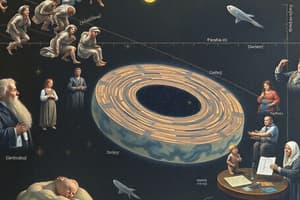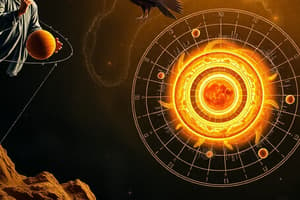Podcast
Questions and Answers
What was the primary contribution of Nicolaus Copernicus to the scientific revolution?
What was the primary contribution of Nicolaus Copernicus to the scientific revolution?
- He invented the telescope and made groundbreaking observations of the planets.
- He formulated the theory of universal gravitation and the laws of motion.
- He developed the laws of planetary motion, describing elliptical orbits.
- He proposed the heliocentric model of the solar system, with the Sun at the center. (correct)
How did the Church initially react to Copernicus's heliocentric theory?
How did the Church initially react to Copernicus's heliocentric theory?
- The Church condemned the theory as heretical and a threat to religious doctrine. (correct)
- The Church immediately embraced the theory and incorporated it into its teachings.
- The Church initially dismissed the theory but later accepted it after further evidence.
- The Church remained neutral and did not take a stance on the theory.
Which astronomer is credited with providing the first observational evidence supporting the heliocentric model?
Which astronomer is credited with providing the first observational evidence supporting the heliocentric model?
- Isaac Newton
- Nicolaus Copernicus
- Galileo Galilei (correct)
- Johannes Kepler
What was the primary contribution of Johannes Kepler to the scientific revolution?
What was the primary contribution of Johannes Kepler to the scientific revolution?
What was the primary contribution of Galileo Galilei to the scientific revolution?
What was the primary contribution of Galileo Galilei to the scientific revolution?
What was the primary contribution of Isaac Newton to the scientific revolution?
What was the primary contribution of Isaac Newton to the scientific revolution?
What was the primary reason for Copernicus's initial hesitation in publishing his heliocentric theory?
What was the primary reason for Copernicus's initial hesitation in publishing his heliocentric theory?
Which astronomer's work was most influential in leading to the eventual acceptance of the heliocentric model by the scientific community?
Which astronomer's work was most influential in leading to the eventual acceptance of the heliocentric model by the scientific community?
What was the primary challenge faced by early proponents of the heliocentric model in convincing the scientific community of its validity?
What was the primary challenge faced by early proponents of the heliocentric model in convincing the scientific community of its validity?
Which of the following statements best describes the impact of the scientific revolution on the relationship between science and religion?
Which of the following statements best describes the impact of the scientific revolution on the relationship between science and religion?
Study Notes
Heliocentric Theory and Its Supporters
- Nicolaus Copernicus proposed the heliocentric theory, positioning the Sun at the center of the solar system.
- Galileo Galilei supported this theory using a telescope, publishing findings in 1632, which confirmed the heliocentric model.
- The Church reacted strongly against Galileo's claims, leading to his forced recantation under threats of excommunication and torture.
- Galileo was placed under house arrest for the remainder of his life.
Influence of Key Scientists
- Johannes Kepler, a Danish mathematician, provided data that further validated the heliocentric theory, establishing it as a universal scientific law.
- Sir Isaac Newton, an English scientist, made significant contributions to the heliocentric theory through his pioneering work in modern physics and the formulation of gravity laws.
- Newton developed calculus to explain planetary motion and made advancements in optics, reinforcing the scientific understanding of the universe.
Galilean Physics and Empiricism
- Aristotle's view held that heavy objects fell faster than lighter ones, but Galileo challenged this through empirical experiments.
- Galileo proved all free-falling objects, regardless of weight, fall at the same rate due to gravity, introducing concepts of acceleration.
Notable Experiments and Discoveries
- The Leaning Tower of Pisa served as a site for Galileo's experiments contrasting cannonballs and musket balls, demonstrating his theories on motion.
- Galileo improved the refracting telescope, revealing previously unseen astronomical phenomena, such as the moon's lunar mountains and craters.
- He discovered four moons orbiting Jupiter, showcasing that not all celestial bodies revolve around Earth, supporting heliocentrism.
- The phases of Venus provided further evidence against the geocentric model.
The Church and Scientific Revolution
- The Catholic Church maintained a stance supporting biblical cosmology, viewing challenges to this as heretical.
- Galileo's conflict with the Inquisition highlighted the tension between science and religion, leading to his eventual house arrest.
- Sir Francis Bacon remarked on the philosophical relationship between human thought and religion.
Legacies of Kepler and Newton
- Johannes Kepler formulated the laws of planetary motion, stating that planets move in elliptical orbits.
- Newton's law of universal gravitation relied on Kepler's principles, marking a significant advancement in scientific understanding during the scientific revolution.
Studying That Suits You
Use AI to generate personalized quizzes and flashcards to suit your learning preferences.
Description
Learn about key figures such as Copernicus, Galileo, and Johannes Kepler who supported the heliocentric theory, along with the Church's reaction. Discover how Sir Isaac Newton further advanced modern physics with scientific contributions.




